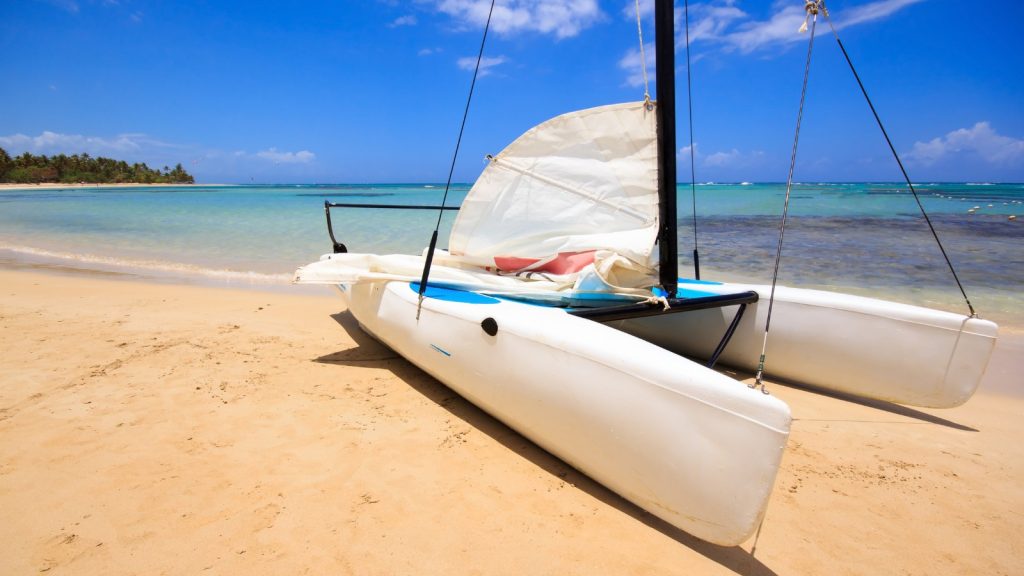The smallest catamaran is ideal for individuals who want to take advantage of sailing freedom without sacrificing comfort and convenience. The smallest catamaran is the best option for sailors of all levels, whether they want to explore quiet bays, take a leisurely afternoon sail, or compete with friends.
It is widely acknowledged that the dinghy is the smallest catamaran in the sailing industry. The dinghy catamaran is performant and versatile despite its small size. This small but formidable boat’s dual hull design offers superb stability and mobility, making it a great option for sailors of all levels.
The dinghy catamaran is the ideal option for you if you want to unwind on the water, improve your racing abilities, or just get away from the stress and issues of everyday life.
The smallest catamaran offers an exhilarating sailing experience that is unsurpassed by any other vessel because to its lightweight build, agile handling, and stable platform.
What is the Smallest Catamaran?
Catamarans are a popular choice for watercraft enthusiasts and adventurers alike. They offer stability, speed, and spacious living quarters, making them a great option for everything from day trips to extended voyages.
One of the most common questions asked by those considering a catamaran is “What is the smallest catamaran?” This article will explore the smallest catamaran options available, their key features, and how they compare to larger catamarans.
What is a Dinghy Catamaran?
A dinghy catamaran is a type of small, lightweight sailing vessel that is designed for recreational use. Dinghy catamarans typically have two parallel hulls, which offer stability and comfort while sailing. They are usually small enough to be transported on a car roof rack or in a small trailer, making them an excellent option for those who enjoy traveling with their sailing vessels.
Dinghy catamarans are excellent choices for both novice and experienced sailors because they are made to be simple to handle and navigate. With the stability of a catamaran and the maneuverability of a conventional dinghy, they provide a fantastic sailing experience.
How Fast Do Dinghy Cats Go?
The speed of a dinghy catamaran depends on several factors, including the design of the vessel, the wind conditions, and the skill of the sailor. Generally speaking, dinghy catamarans are capable of reaching speeds of up to 20 knots (23 mph) or more, depending on the conditions.
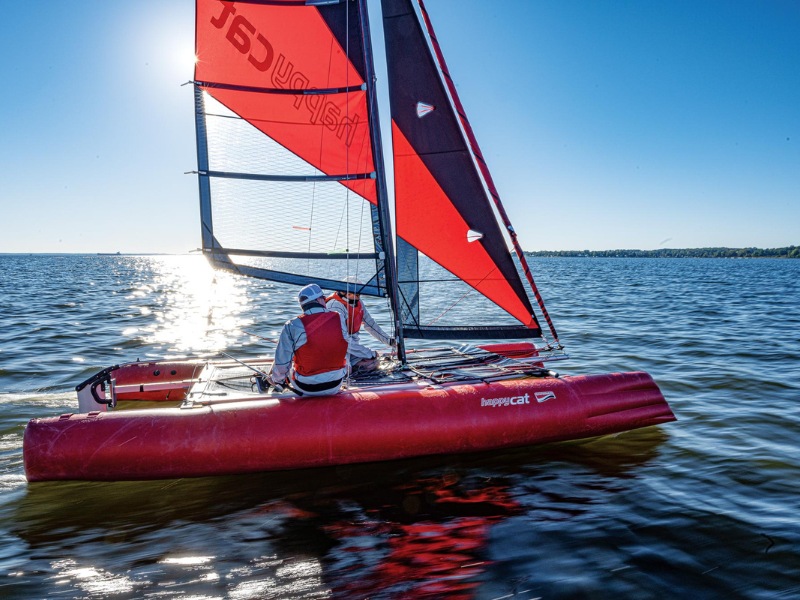
In light wind conditions, a dinghy catamaran may move at a slower pace, while in stronger winds, it can reach much higher speeds. The skill of the sailor also plays a role in the speed of the dinghy catamaran, as experienced sailors are able to make the most of the wind and water conditions to achieve maximum speed.
It’s crucial to remember that when it comes to dinghy catamarans, speed is not the only thing to take into account. They are a fantastic choice for both racing and leisure sailing because they can go at high speeds and still maintain exceptional stability. Dinghy catamarans are a well-liked option for sailors of all skill levels because of their balance of speed and stability.
The Smallest Catamarans on the Market
The “smallest” catamarans on the market include a few different models. However, depending on a person’s needs and preferences, what is considered “small” can change. If a catamaran can be moved easily, some people may view it as being small, while others may place more importance on the amount of living and storage space. In light of it, the following are some of the smallest catamarans on the market:
Hobbie Cat
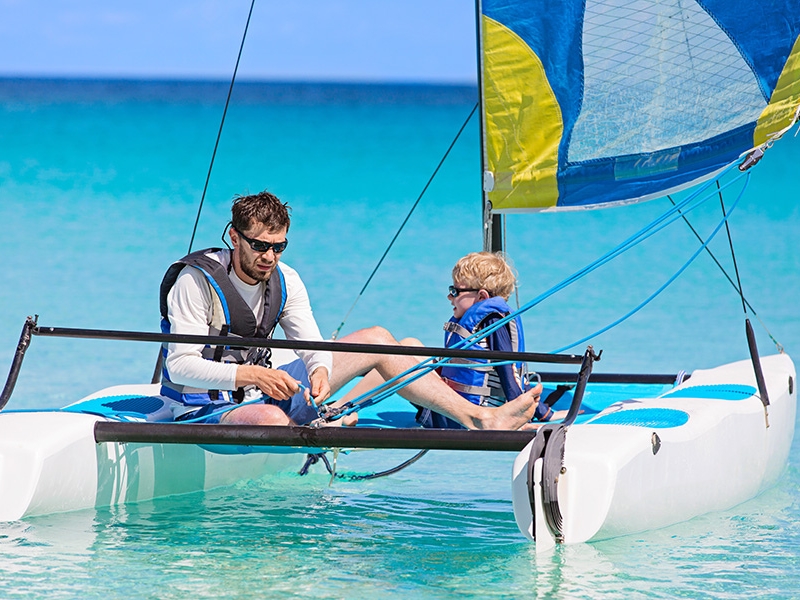
The Hobie Cat is often regarded as the smallest catamaran available, and a used one may be purchased for a reasonable price.
This small catamaran is 16 ft 7 in (5.05 m) long and 7 ft 11 in (2.41 m) broad. It also features a mast that stands 26 feet 6 inches (8.08 meters) tall. Surprisingly, it weights only 320 lb (150 kg). It is designed, like the 14, to be sailed from the beach through the surf and then surfed back in on the waves to the shore.
The Hobie Mirage Tandem Island
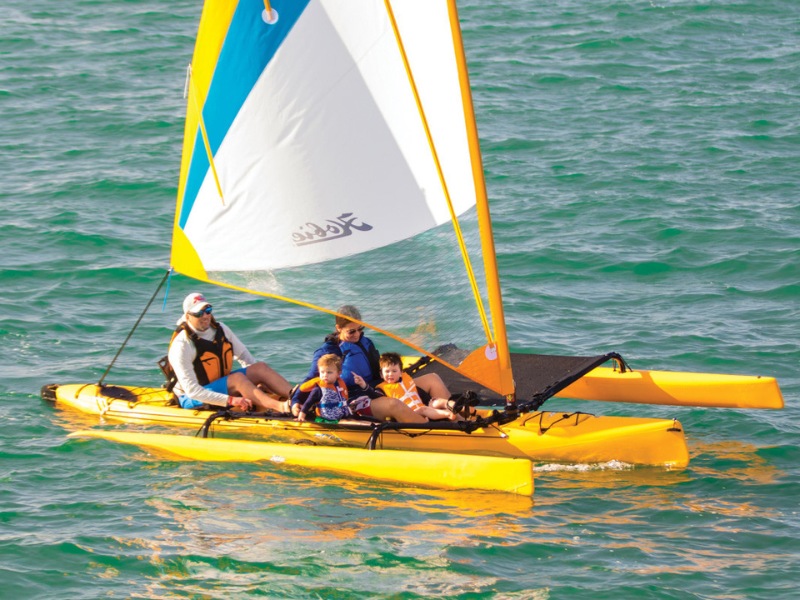
For those who prefer more space, the Hobie Mirage Tandem Island is a larger catamaran that is ideal. This catamaran, which measures little over 14 feet in length, is still considered small by most standards but provides a lot more room and comforts than the Dagger Stratos.
The Hobie Mirage Tandem Island is a fantastic alternative for individuals who like to spend a lot of time on the water because it comes with two sizable trampolines, a roomy cabin, and numerous storage possibilities.
The Nacra Infusion Micro
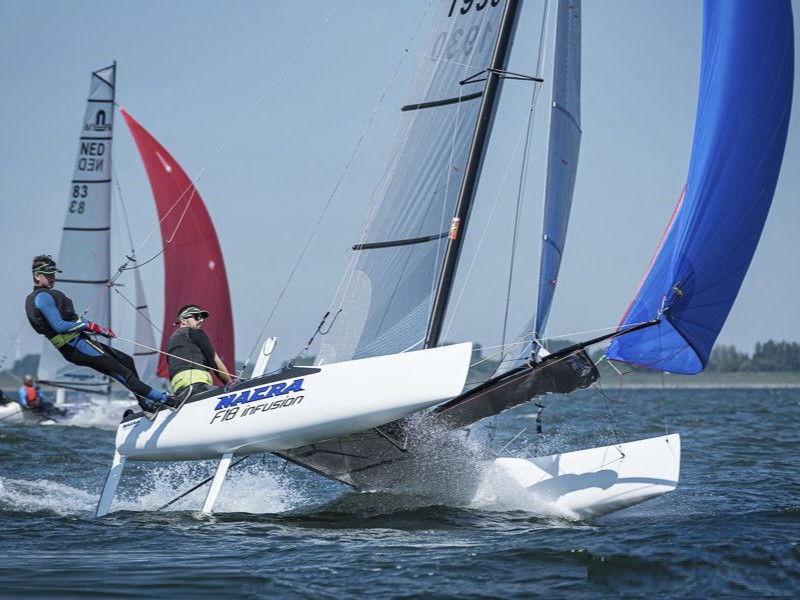
A high-performance catamaran made specifically for racing enthusiasts is called the Nacra Infusion Micro. This catamaran is still small by conventional standards, measuring just under 15 feet, but it has tremendous speed and agility, making it a fantastic choice for individuals who wish to take part in races or other high-performance activities on the water.
The Nacra Infusion Micro is an excellent alternative for individuals who wish to spend a lot of time on the water despite its small size because it is fitted with a number of features, such as a roomy cockpit and a range of storage possibilities.
Key Features of the Smallest Catamarans
There are several key features that make the smallest catamarans unique and desirable.
Here are a few of the most important:
- Portability: Many of the smallest catamarans are designed with portability in mind, making them easy to transport and store. This is a great option for those who want to take their catamaran on the road or who have limited space.
- Stability: Despite their small size, many of the smallest catamarans offer excellent stability, making them a great option for recreational paddlers and racing enthusiasts alike.
- Performance: The smallest catamarans are designed for high performance, making them a great option for those who want to participate in races or other high-performance activities on the water.
- Living Space: Some of the smallest catamarans offer more living space and storage capacity
Considerations When Choosing the Smallest Catamaran
There are a number of important factors to take into account while selecting the smallest catamaran that is best for you:
- Purpose: What will you be using your catamaran for? Will you be using it primarily for recreational paddling, racing, or extended voyages? Knowing your purpose will help you choose the catamaran that is best suited to your needs.
- Budget: What is your maximum catamaran purchase price range? It’s crucial to have a budget in mind before you start shopping for the smallest catamarans because their prices can range from a few hundred to several thousand dollars.
- Storage: How much storage space do you need? If you plan on spending extended periods of time on the water, you may need more storage space for supplies, food, and other essentials.
- Portability: How important is portability to you? If you plan on taking your catamaran on the road, you may want to choose a smaller catamaran that is easy to transport.
- Performance: How significant do you think performance is? You might choose to select a smaller catamaran with performance features if you intend to compete in races or other high-performance activities on the sea.
Is Sailing a Dinghy Catamaran Easy?
Depending on the sailor’s experience and the wind conditions, sailing a dinghy catamaran can be simple or difficult.
Dinghy catamaran sailing can be manageable for novices because they are often built to be stable and maneuverable. Many dinghy catamarans also have simplified rigging systems, which makes them simple to rig and sail.
On the other hand, sailing in strong winds or rough seas can be more difficult and call for more expertise and experience. To keep control of the boat in these situations, sailors must be able to act quickly and modify their sailing skills.
Overall, a dinghy catamaran’s ease of sailing might change depending on the sailor and the conditions they are sailing in. Even novice sailors can develop their skills and become adept navigators of their dinghy catamarans with time and practice.
Are Dinghy Cats Easy to Maneuvre?
Dinghy catamarans are generally considered to be easy to maneuver. This is due to several factors, including their lightweight construction, stability, and design.
A dinghy catamaran’s two parallel hulls provide exceptional stability, enabling the sailor to perform quick, sharp turns without capsizing. Additionally, dinghy catamarans’ lightweight design makes them highly responsive to the sailor’s directions, enabling fluid and accurate turns.
Can a Dinghy Catamaran Flip Over?
Yes, it is possible for a dinghy catamaran to flip over, just like any other sailing vessel. This can occur due to several factors, including high winds, waves, and poor sailing technique.
However, compared to monohull sailboats, dinghy catamarans are considered to be more stable and less likely to flip over. The two parallel hulls of a dinghy catamaran offer excellent stability, allowing the sailor to make quick and sharp turns without capsizing. Additionally, the lightweight construction of dinghy catamarans makes them highly responsive to the sailor’s commands, allowing for smooth and precise maneuvers.
That being said, it’s still important for sailors to follow proper safety procedures and use caution when sailing in challenging conditions, such as high winds and waves. By following best practices and being prepared for potential hazards, sailors can minimize the risk of flipping their dinghy catamaran.
What should you do if your dinghy catamaran capsizes?
If your dinghy catamaran has flipped over, there are several steps you can take to right it and recover it, even if you’re sailing solo. Here’s what to do:
- Climb onto the overturned hull: Start by swimming over to the overturned hull and climbing onto it. It’s important to stay as calm as possible and keep your body weight centered on the hull to prevent the catamaran from flipping over again.
- Remove any excess water: If there’s water in the hulls, remove it using a bailer or bucket. This will reduce the weight and make it easier to right the catamaran.
- Shift your weight: Once you’ve removed any excess water, shift your weight towards the bow of the hull closest to the water’s surface. By doing this, you’ll help the catamaran start to right itself.
- Climb back into the boat: As the catamaran starts to right itself, climb back into the boat and shift your weight to the opposite hull to help balance it. It’s important to move slowly and deliberately to avoid capsizing the boat again.
- Re-rig the sails: Once you’ve righted the boat, re-rig the sails and start sailing again. Make sure to check all the equipment and ensure that everything is secure before setting off again.
It’s crucial to rehearse these procedures and be ready for a capsize, especially if you’re sailing in rough conditions. You’ll be more prepared to tackle any potential issues on the sea if you’re organized and know how to recover your dinghy catamaran on your own.
Conclusion
The smallest catamaran is a fantastic choice for both watercraft fans and intrepid travelers. There is a great option for everyone, whether they want a recreational ship, a racing vessel, or an extended traveler.
It’s critical to consider your goal, affordability, storage constraints, portability, and performance requirements while selecting the smallest catamaran that would work best for you.
With so many great options available, you’ll surely find the smallest catamaran that is perfect for your needs.

